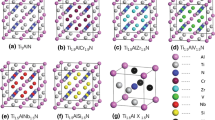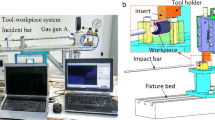Abstract
In this paper, the microscopic mechanism of 080A15 and 30CrMnMo steel chip failure modes has been studied at the level of valence electron structure (VES) based on the empirical electron theory (EET) of solids and molecules. Studies show the bonding ability and the lattice electron density are related to the chip failure form. If the bonding ability is weak and the lattice electron density is high, the chip is more prone to ductile fracture. Conversely, the chip is more prone to adiabatic shear failure to form the serrated chip divided uniformly by adiabatic shear bands (ASBs). For 080A15 steel, the bonding force between atoms is weak, and the lattice electron density is very high. It is difficult to produce the thermal-mechanical instability. Thus, the chip was formed by ductile fracture. For 30CrMnMo steel, the total bonding ability of each structural unit of carbon and alloy elements is stronger, and the lattice electron density of each structural unit is weaker, the temperature can rise instantaneously to a very high level to form the serrated chip with the adiabatic shear failure. The results of this research provide useful insights on material design and selection in high-speed cutting by studying the specific alloy elements on the influence of chip failure mechanism at the VES level.
Similar content being viewed by others
References
Abukhshim NA, Mativenga PT, Sheikh MA (2006) Heat generation and temperature prediction in metal cutting: a review and implications for high speed machining. Int J Mach Tools Manuf 46(7–8):782–800
Ye GG, Xue SF, Ma W, Jiang MQ, Ling Z, Tong XH, Dai LH (2012) Cutting AISI 1045 steel at very high speeds. Int J Mach Tools Manuf 56:1–9
Liu ZQ, Zhang KG (2011) Sensitivity analysis of Johnson-Cook material constants on adiabatic shear. Chin J Aeronaut 32:2140–2146
Schulz H, Abele E, Sahm A (2001) Material aspects of chip formation in HSC machining. CIRP 50(1):45–48
Shih AJ, Luo J (2004) Chip morphology and forces in end milling of elastomers. J Manuf Sci Eng ASME 126:124–130
Ohbuchi Y, Obikawa T (2002) Evaluation of grindability of materials based on abrasive cutting simulation. Trans Jpn Soc Mech Eng 68:315–322
Yang QB, Liu ZQ, Wang B (2012) Characterization of chip formation during machining 1045 steel. Int J Adv Manuf Technol 63:881–886
Yang QB, Liu ZQ, Shi ZY, Wang B (2014) Analytical modeling of adiabatic shear band spacing for serrated chip in high-speed machining. Int J Adv Manuf Technol 71:1901–1908
Barry J, Byrne G (2002) The mechanisms of chip formation machining hardened steels. J Manuf Sci Eng ASME 124:528–535
Wang CY, Xie YX, Zheng LJ, Qin Z, Tang DW, Song YX (2014) Research on the chip formation mechanism during the high-speed milling of hardened steel. Int J Mach Tools Manuf 79:31–48
Dong G, Zhaopeng H, Rongdi H, Yanli C, Muguthu JN (2011) Study of cutting deformation in machining nickel-based alloy inconel718. Int J Mach Tools Manuf 51:520–527
Wang H, To S, Chan CY, Cheung CF, Lee WB (2011) Dynamic modelling of shear band formation and tool-tip vibration in ultra-precision diamond turning. Int J Mach Tools Manuf 51:512–519
Gu LY, Wang MJ (2013) Experimental and theoretical research on critical characteristics for adiabatic shear localization fracture in high-speed machining. Int J Adv Manuf Technol 68:1231–1240
Khrais SK, Lin YJ (2007) Wear mechanisms and tool performance of TiAlN PVD coated inserts during machining of AISI 4140 steel. Wear 262:64–69
Xu YB, Bai YL (2007) Shear localization, microstructure evolution and fracture under high-strain rate. Adv Mech 37:498
Xu YB, Zhang J, Bai YL, Meyers M (2008) Shear localization in dynamic deformation: microstructural evolution. Metall Mater Trans A 39A:811
Duan CZ, Wang MJ (2013) A review of microstructural evolution in the adiabatic shear bands induced by high speed machining. Acta Metall Sin 26:97–112
Dodd B, Bai YL (1992) Adiabatic shear localization. Pergamon Press, New York
Wright TW (2002) The physics and mathematics of adiabatic shear bands. Cambridge University Press, Cambridge
Bäker M, Rösler J, Siemers C (2003) The influence of thermal conductivity on segmented chip formation. Comput Mater Sci 26:175–182
Poulachon G, Moisan AL (1999) Hard turning: chip formation mechanisms and metallurgical aspects. J Manuf Sci Eng 122:406–412
Yü RH (1978) The empirical electron theory of solids and molecules. Chin Sci Bull 4:217–224
Zhang RL (1992) The empirical electron theory of solids and molecules. Jinlin Science and Technology Publishing House, Changchun
Liu ZL, Li ZL, Sun ZG (1999) Catalysis mechanism and catalyst design of diamond growth. Metall Mater Trans A 30A:1999–2757
Li ZL, Xu HB, Gong SK (2004) Texture formation mechanism of vapor-deposited fcc thin film on polycrystal or amorphous substrate. J Phys Chem B 108:15165–15171
Guo YQ, Yü RH, Zhang RL, Zhang XH, Tao K (1998) Calculation of magnetic properties and analysis of valence electronic structures of LaT13-xAlx (T = Fe, Co) compounds. J Phys Chem B 102(1):9–16
Liu ZL, Li ZL, Liu WD (2002) Interface electron structure and interfacial properties. Science Publishing House, Beijing
Liu ZL (1990) Valence electron structure and composition design of alloy. Jinlin Science and Technology Publishing House, Changchun
Peng K, Yi M, Ran L, Ge Y (2011) Effect of the W addition content on valence electron structure and properties of MoSi2-based solid solution alloys. Mater Chem Phys 129(3):990–994
Liu ZL, Li ZL, Sun ZG, Yang XP, Chen M (1995) Valence electron structure of cast iron and graphitization behavior criterion of elements. Sci China Ser A Math 38(12):1484–1491
Mi G, Li P, He L, Попель ПС (2010) EET research on melt structural information of magnesium alloy. Rare Met Mater Eng 39:1881–1887
Liu ZL, Liu WD, Lin C (2004) Prediction of end-roll strength and rapid adjustment of the on-the-spot composition in automobile cross-beam steel. Prog Nat Sci 14(12):1104–1108
Liu ZL, Lin C, Liu Y, Guo Y (2005) Calculation of the yield and tensile strength in the alloying non quenched-tempered steel by the electron structure parameters. Prog Nat Sci 15:832–837
Liu WS, Feng PZ, Wang XH, Niu JA, Shen CJ, Liu JT (2012) Calculation and analysis of the valence electron structure of MoSi2 and (Mo0.95, Nb0.05)Si2. Mater Chem Phys 132(2–3):515–519
Lin C, Yin GL, Zhao YQ, Ge P, Liu ZL (2011) Analysis of the effect of alloy elements on martensitic transformation in titanium alloy with the use of valence electron structure parameters. Mater Chem Phys 125(3):411–417
Yü RH (1982) Analysis of valence electron and magnetic moment structures of α-Fe, γ-Fe and Fe4N—electron theory of case hardening α-toγ-Fe phase transformation and certain other related processes. Acta Metall Sin 18:337–347
Liu Z-L, Niu H-J, Jin C-F, Wang B (1989) A theory of C-Si segregation in Fe-C-Si alloys (I). Chin Sci Bull 34:100–104
Liu ZL, Lin C, Guo Y (2006) Theoretical calculation of the finishing rolling elongation in alloying non-quenched and tempered steel. Prog Nat Sci 16:859–867
Yü RH (1984) Interpretation of melting point and certain other physical and chemical properties of CrO3, δ-CrO2, Cr2O3, α-Al2O3 by their valence electron structures. J Struct Chem 03:193–208
Lin C, Zhao Y, Yin G (2015) Calculation of the lattice constant of solids with the use of valence electron structure parameters. Comput Mater Sci 97(1):86–93
Liu H-j, Cao J-g, Wang B-f, Li J-c, Xu Z-h (2010) 30CrMnMo numerical simulation of quenching seamless tube. J Inn Mong Univ Sci Technol 29(3):238
Lu JM (2004) The practical manual of mechanical engineering materials. Liaoning Science and Technology Publishing House, Shenyang
Li J-q, Huang D-w, Wang M-j (2010) Effect of valence electron structures of different targets on deformations of tungsten alloy penetrators. J Mater Eng 07:61
Author information
Authors and Affiliations
Corresponding author
Electronic supplementary material
Below is the link to the electronic supplementary material.
ESM 1
(DOC 440 kb)
Rights and permissions
About this article
Cite this article
Li, Jq., Zhang, R., Guo, Hl. et al. Study on chip failure mechanism in high-speed cutting process with electronic theory. Int J Adv Manuf Technol 84, 2257–2264 (2016). https://doi.org/10.1007/s00170-015-7852-1
Received:
Accepted:
Published:
Issue Date:
DOI: https://doi.org/10.1007/s00170-015-7852-1




